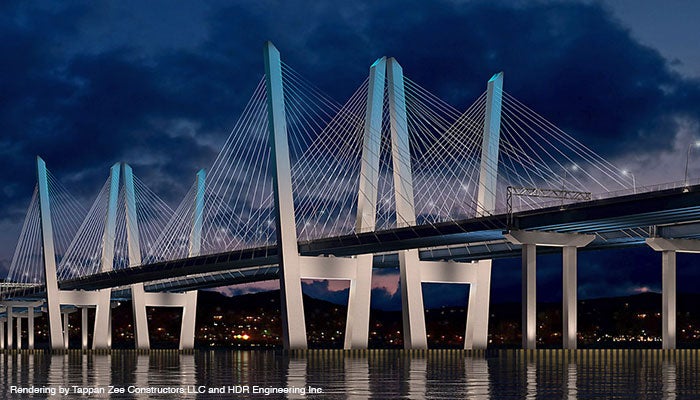Travel south down the Thruway from Troy toward New York City and you’ll eventually run into an engineering marvel: the Tappan Zee Bridge, a 60-year-old, 3.1-mile span across the Hudson River that is the longest bridge in New York state. The New York State Thruway Authority estimates that 138,000 cars travel the bridge daily.
After more than 60 years of carrying commuters across the Hudson, the bridge is being replaced by twin, four-lane spans designed to last for a century; the replacement project, which has a nearly $4 billion price tag, is scheduled to be completed in 2018. The original bridge was built for $60 million and was designed to last only 50 years when it opened in 1955.

Emil Praeger
New York Gov. Thomas Dewey (of the famous 1948 headline faux pas “Dewey Defeats Truman”) is credited with the bridge’s location connecting Nyack and Tarrytown. Located at one of the widest points of the river, the bridge is also located just outside the jurisdiction of the Port Authority, meaning tolls collected on the bridge go into state, not Port Authority, coffers.
Dewey also championed the World War II technology that would enable the bridge’s construction. That technology was the brainchild of a Rensselaer graduate and former faculty member, Emil Praeger.
Praeger, a Class of 1915 graduate and the head of the Civil Engineering Department from 1939 to 1946, designed the bridge using a technique he developed during World War II. While serving as a Navy captain in 1944, Praeger was tasked with devising a system to keep the Allied troops safe as they crossed the English Channel to storm the beach of Normandy.
Drawing on his already extensive civil engineering and military background (he also served in World War I), Praeger designed concrete breakwaters that could be floated into place to form a protected harbor, allowing the troops safe access to the beach.

Eight underwater concrete caissons support about 70 percent of the bridge’s dead weight. The caissons incorporate a “buoyant” design that stores pressurized air within small compartments.
Those floating concrete caissons, nicknamed “Phoenix” caissons, were used a decade later to form the foundation of the Tappan Zee Bridge. During construction, which was overseen by Praeger, massive caissons, some as long as a city block, were made in pits near the construction site. When they were completed, the pits were flooded and the caissons were floated to the site of the rising bridge.
Praeger was a prolific civil engineer, working on projects as varied as baseball stadiums (Shea and Dodger) and renovations to Harry S. Truman’s White House. In addition to the Tappan Zee, Praeger also worked on the Throgs Neck and Verrazano Narrows bridges in New York City. He was inducted into the Rensselaer Alumni Hall of Fame in 1998.
The connection between Rensselaer and the Tappan Zee Bridge is alive today—undergraduates in the Department of Civil and Environmental Engineering traveled to the Tappan Zee construction site in October and department head Chris Letchford said the trip will be an annual pilgrimage for undergraduates.
Special thanks to the staff of the Rensselaer Archives for their assistance with research for this article.


